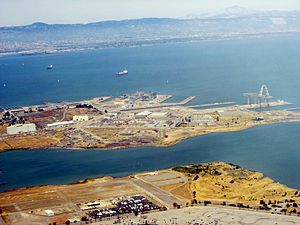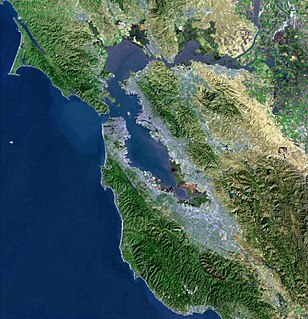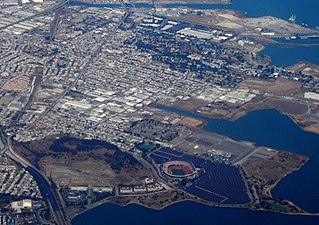This article needs additional citations for verification .(April 2009) (Learn how and when to remove this template message) |
| San Francisco Naval Shipyard | |
|---|---|
| San Francisco | |
2006 aerial view of the former San Francisco Naval Shipyard. View looking northeast | |
| Coordinates | 37°43′32.18″N122°22′8.19″W / 37.7256056°N 122.3689417°W |
| Type | Shipyard |
| Site information | |
| Controlled by | United States Navy |
| Site history | |
| Built | 1870 |
| In use | 1941–1974 |
| Battles/wars | World War I, World War II, Cold War |
The San Francisco Naval Shipyard was a United States Navy shipyard in San Francisco, located on 638 acres (258 ha) of waterfront at Hunters Point in the southeast corner of the city.

The United States Navy (USN) is the naval warfare service branch of the United States Armed Forces and one of the seven uniformed services of the United States. It is the largest and most capable navy in the world, with the highest combined battle fleet tonnage and the world's largest aircraft carrier fleet, with eleven in service, and two new carriers under construction. With 319,421 personnel on active duty and 99,616 in the Ready Reserve, the Navy is the third largest of the service branches. It has 282 deployable combat vessels and more than 3,700 operational aircraft as of March 2018, making it the second largest and second most powerful air force in the world.

A shipyard is a place where ships are built and repaired. These can be yachts, military vessels, cruise liners or other cargo or passenger ships. Dockyards are sometimes more associated with maintenance and basing activities than shipyards, which are sometimes associated more with initial construction. The terms are routinely used interchangeably, in part because the evolution of dockyards and shipyards has often caused them to change or merge roles.
Contents
Originally, Hunters Point was a commercial shipyard established in 1870, consisting of two graving docks. It was purchased and built up in the late nineteenth and early twentieth century by the Union Iron Works company, later owned by the Bethlehem Shipbuilding Company and named Hunters Point Drydocks, located at Potrero Point.
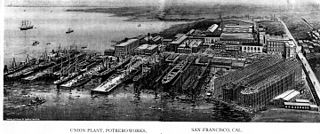
Union Iron Works, located in San Francisco, California, on the southeast waterfront, was a central business within the large industrial zone of Potrero Point, for four decades at the end of the nineteenth and beginning of the twentieth centuries.

Potrero Point in San Francisco, California, is the location of the earliest and most important industrial facilities in the Western United States on the eastern extension of San Francisco's Potrero Hill, a natural land mass extending into San Francisco Bay south of Mission Bay. Potrero Point, the point of Potrero Hill, was systematically blasted and cut, its serpentine cliffs removed. The work yielded two square miles of rock for fill and hundreds of acres of flat industrial land east of Illinois Street between 20th Street and Islais Creek.
The shipyard was purchased by the Navy in 1940, a year before the attack on Pearl Harbor. It began operations the next year as the San Francisco Naval Shipyard, and operated until 1974 when it was deactivated and renamed Hunters Point Naval Shipyard. Used commercially for a time, in 1986 it was taken over by the Navy again as the home port of the USS Missouri battlegroup, under the name Treasure Island Naval Station Hunters Point Annex.
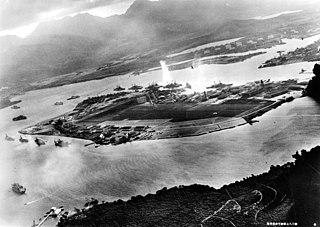
The Attack on Pearl Harbor was a surprise military strike by the Imperial Japanese Navy Air Service against the United States naval base at Pearl Harbor, Hawaii Territory, on the morning of December 7, 1941. The attack, also known as the Battle of Pearl Harbor, led to the United States' formal entry into World War II. The Japanese military leadership referred to the attack as the Hawaii Operation and Operation AI, and as Operation Z during its planning.

USS Missouri (BB-63) is an Iowa-class battleship and was the third ship of the United States Navy to be named after the U.S. state of Missouri. Missouri was the last battleship commissioned by the United States and is best remembered as the site of the surrender of the Empire of Japan which ended World War II.
The base was named redundant as part of the Base Realignment and Closure effort in 1991, and was closed permanently in 1994. Since then the site has been part of a superfund cleanup effort to remediate the leftovers of decades of industrial and radiological use. Parcels are being sold off as they are cleaned up, mostly for condominium development.
Base Realignment and Closure (BRAC) is a process by a United States federal government commission to increase United States Department of Defense efficiency by planning the end of the Cold War realignment and closure of military installations. More than 350 installations have been closed in five BRAC rounds: 1988, 1991, 1993, 1995, and 2005.

Superfund is a United States federal government program designed to fund the cleanup of sites contaminated with hazardous substances and pollutants. Sites managed under this program are referred to as "Superfund" sites. It was established as the Comprehensive Environmental Response, Compensation, and Liability Act of 1980 (CERCLA). It authorizes federal natural resource agencies, primarily the Environmental Protection Agency (EPA), states and Native American tribes to recover natural resource damages caused by hazardous substances, though most states have and most often use their own versions of CERCLA. CERCLA created the Agency for Toxic Substances and Disease Registry (ATSDR). The EPA may identify parties responsible for hazardous substances releases to the environment (polluters) and either compel them to clean up the sites, or it may undertake the cleanup on its own using the Superfund and costs recovered from polluters by referring to the U.S. Department of Justice.
A condominium, often shortened to condo, in the United States and in most Canadian provinces, is a type of living space similar to an apartment but independently sellable and therefore regarded as real estate. The condominium building structure is divided into several units that are each separately owned, surrounded by common areas that are jointly owned. Similar concepts in other English-speaking countries include strata title in Australia, Malaysia, New Zealand, and the Canadian province of British Columbia; commonhold in the United Kingdom; and sectional title in South Africa.
